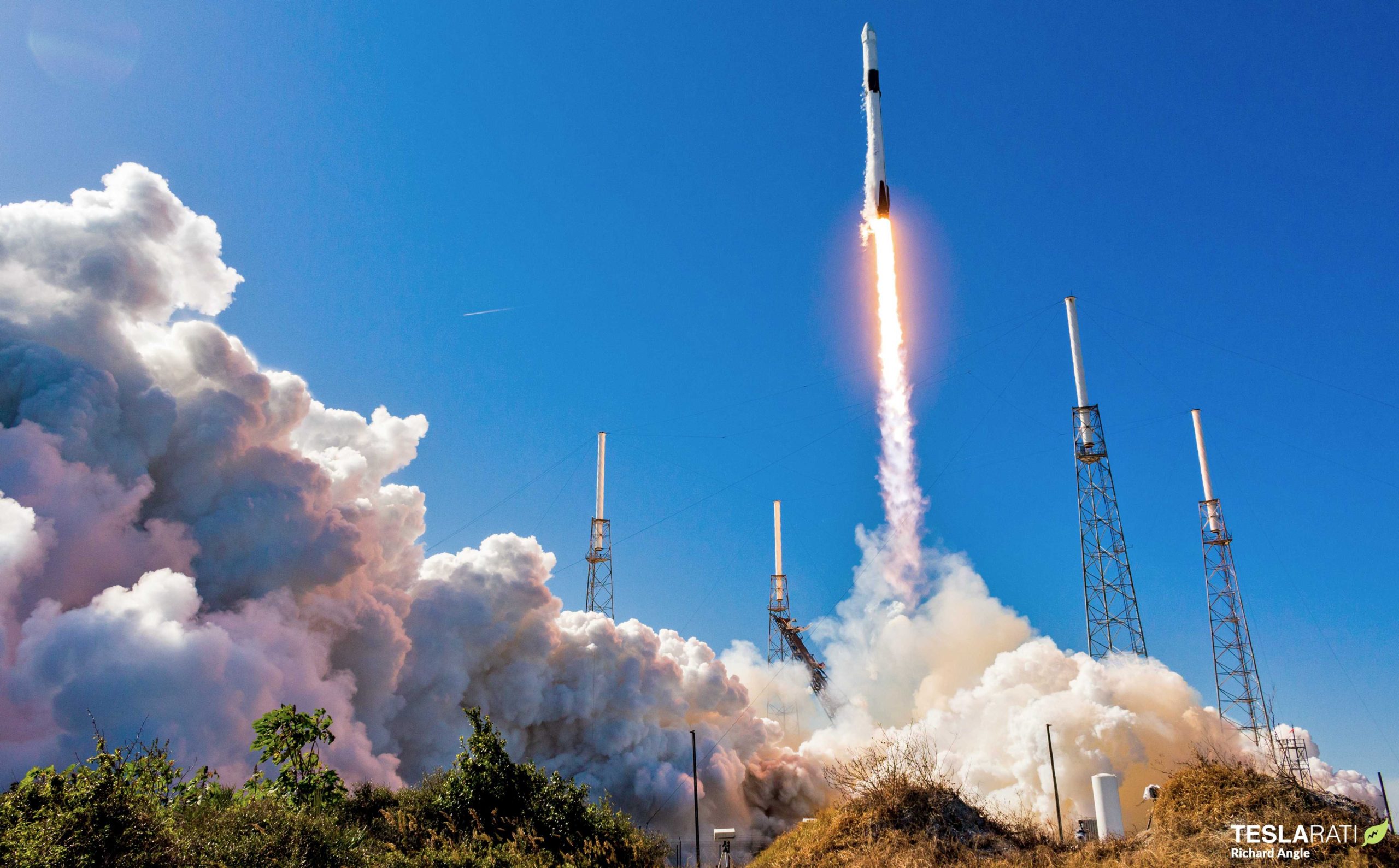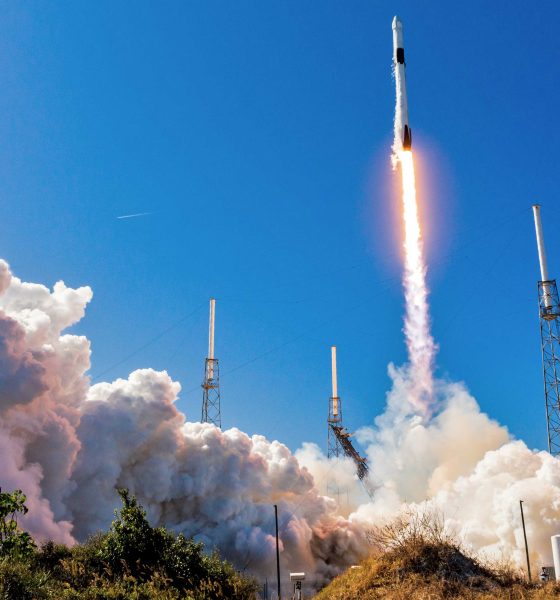

Space
SpaceX wins NASA contract to launch Earth Observing System, but current administration has other plans
SpaceX recently snagged an $80.4 million NASA contract to launch an upcoming Earth-observing satellite sometime in 2022. That is, if the mission isn’t scrapped due to budgetary issues.
A used Falcon 9 rocket is slated to ferry the 3,748-lb. (1,700 kg) Plankton, Aerosol, Cloud, and ocean Ecosystem satellite (aka PACE) to orbit sometime in December 2022. The mission, which provides data on oceans and particles in the atmosphere, is expected to launch from Cape Canaveral Air Force Station in Florida.
Its goal: to help us better understand our home planet. SpaceX is expanding its portfolio, after receiving certification for science launches in 2016. To date, SpaceX launched a bevy of scientific satellites including Jason-3 in 2106, the Transiting Exoplanet Survey Satellite (TESS) and GRACE-FO missions in 2018, and the upcoming Sentinel 6A in Nov. 2020.
But it’s been a tough journey for PACE. The satellite has been on the chopping block several times, but managed to avoid getting the ax so far.
That’s because the Trump administration has tried to cancel the ocean-watching mission three separate times now, in an effort to reduce the Earth science budget. Each time the president has tried to cut its funding, Congress voted to support it, including authorizing $131 million for the mission in December 2019.
So NASA has moved ahead with the development of the mission, and selected SpaceX as the launch provider on Feb. 4.
“SpaceX is honored to continue supporting NASA’s critical scientific observational missions by launching PACE, which will help humanity better understand, protect and preserve our planet,” Gwynne Shotwell, SpaceX’s president and chief operating officer, said in a company statement.
PACE will focus on our planet’s oceans, the clouds, and aerosols (small air particles) in an effort to better understand phytoplankton — tiny plant-like organisms in the ocean that are the base of the food chain. These organisms can tell us a lot about how climate change is affecting the environment.
“PACE will help scientists investigate the diversity of organisms fueling marine food webs and the U.S. economy, and deliver advanced data products to reduce uncertainties in global climate models and improve our interdisciplinary understanding of the Earth system,” NASA said in a statement.
“It will also continue systematic records of key atmospheric variables associated with air quality and Earth’s climate,” officials wrote on the PACE mission’s website.
Like most plants, phytoplankton relies on chlorophyll to capture sunlight, and then using photosynthesis to turn it into chemical energy, releasing oxygen as a byproduct.

Phytoplankton are a diverse variety of species and their growth depends on the availability of things like carbon dioxide, sunlight, and nutrients. Just like their terrestrial counterparts, phytoplankton require can nutrients such as nitrate, phosphate, silicate, and calcium, depending on the species.
Other factors that influence growth rates are water temperature and salinity, water depth, wind, as well as what sort of predators are nearby.
When conditions are just right, phytoplankton populations can grow explosively, a phenomenon we call a bloom. Blooms in the ocean may cover hundreds of square kilometers and are easily spotted in satellite imagery. A bloom may last several weeks, although the life expectancy of any individual organism is rarely more than a few days.
Phytoplankton are important because they are the foundation of the aquatic food web, feeding many different creatures from other microscopic organisms to enormous, mega-ton whales.
Phytoplankton aren’t always a good thing — certain species are known to produce powerful biotoxins, like the red tide. These toxic blooms can kill marine life and ultimately people if they accidentally eat contaminated seafood or by inhaling the organisms.

PACE’s primary tool is called the Ocean Color Instrument (OCI). It will measure the color of the ocean in a broad range of wavelengths, from ultraviolet to shortwave infrared, according to NASA. The satellite will observe the Earth from an orbital perch about 420 miles (675 kilometers) above the planet. (For reference, the space station orbits at 250 miles or 400 km up.)
“The color of the ocean is determined by the interaction of sunlight with substances or particles present in seawater, such as chlorophyll, a green pigment found in most phytoplankton species,” according to the mission’s website. “By monitoring global phytoplankton distribution and abundance with unprecedented detail, the OCI will help us to better understand the complex systems that drive ocean ecology.”
PACE will be in a sun-synchronous orbit, which will allow for consistent daylight conditions for imaging. This makes it easier for scientists to compare different regions and the same regions over long periods of time — if the satellite makes it to orbit.
Today, the president released his budget request for 2021, and once again, PACE is one of two Earth science missions he wants to cancel. Will its luck hold out? Will Congress vote to approve funding for the vital satellite despite the president’s suggestion? Only time will tell.
But with many coastal states recently suffering from red tide, this satellite will be a valuable tool in scientists’ arsenal to help them better understand these tiny organisms.

News
SpaceX shades airline for seeking contract with Amazon’s Starlink rival

SpaceX employees, including its CEO Elon Musk, shaded American Airlines on social media this past weekend due to the company’s reported talks with Amazon’s Starlink rival, Leo.
Starlink has been adopted by several airlines, including United Airlines, Qatar Airways, Hawaiian Airlines, WestJet, Air France, airBaltic, and others. It has gained notoriety as an extremely solid, dependable, and reliable option for airline travel, as traditional options frequently cause users to lose connection to the internet.
Many airlines have made the switch, while others continue to mull the options available to them. American Airlines is one of them.
A report from Bloomberg indicates the airline is thinking of going with a Starlink rival owned by Amazon, called Leo. It was previously referred to as Project Kuiper.
American CEO Robert Isom said (via Bloomberg):
“While there’s Starlink, there are other low-Earth-orbit satellite opportunities that we can look at. We’re making sure that American is going to have what our customers need.”
Isom also said American has been in touch with Amazon about installing Leo on its aircraft, but he would not reveal the status of any discussions with the company.
The report caught the attention of Michael Nicolls, the Vice President of Starlink Engineering at SpaceX, who said:
“Only fly on airlines with good connectivity… and only one source of good connectivity at the moment…”
CEO Elon Musk replied to Nicolls by stating that American Airlines risks losing “a lot of customers if their connectivity solution fails.”
American Airlines will lose a lot of customers if their connectivity solution fails
— Elon Musk (@elonmusk) December 14, 2025
There are over 8,000 Starlink satellites in orbit currently, offering internet coverage in over 150 countries and territories globally. SpaceX expands its array of satellites nearly every week with launches from California and Florida, aiming to offer internet access to everyone across the globe.
Currently, the company is focusing on expanding into new markets, such as Africa and Asia.
News
Tesla hints at Starlink integration with recent patent
“By employing polymer blends, some examples enable RF transmission from all the modules to satellites and other communication devices both inside and outside the vehicle.”

Tesla hinted at a potential Starlink internet terminal integration within its vehicles in a recent patent, which describes a vehicle roof assembly with integrated radio frequency (RF) transparency.
The patent, which is Pub. No U.S. 2025/0368267 describes a new vehicle roof that is made of RF-transparent polymer materials, allowing and “facilitating clear communication with external devices and satellites.”
Tesla believes that a new vehicle roof design, comprised of different materials than the standard metallic or glass elements used in cars today, would allow the company to integrate modern vehicular technologies, “particularly those requiring radio frequency transmission and reception.
Tesla has recently filed a US patent application on integrating RF transparent materials into the roof structure.
“facilitating clear communication with external devices and satellites”
Tesla fleet is getting @Starlink connectivity integration soon. LFG @Tesla @elonmusk… pic.twitter.com/bLa8YtPLd1
— Chansoo Byeon (@Chansoo) December 9, 2025
Instead of glass or metallic materials, Tesla says vehicles may benefit from high-strength polymer blends, such as Polycarbonate, Acrylonitrile Butadiene Styrene, or Acrylonitrile Styrene Acrylate.
These materials still provide ideal strength metrics for crashworthiness, stiffness for noise, vibration, and harshness control, and are compliant with head impact regulations.
They would also enable better performance with modern technologies, like internet terminals, which need an uninterrupted signal to satellites for maximum reception. Tesla writes in the patent:
“By employing polymer blends, some examples enable RF transmission from all the modules to satellites and other communication devices both inside and outside the vehicle.”

One of the challenges Tesla seems to be aware of with this type of roof design is the fact that it will still have to enable safety and keep that at the forefront of the design. As you can see in the illustration above, Tesla plans to use four layers to increase safety and rigidity, while also combating noise and vibration.
It notes in the patent that disclosed examples still meet the safety requirements outlined in the Federal Motor Vehicle Safety Standards (FMVSS).
Starlink integrated directly into Tesla vehicles would be a considerable advantage for owners. It would come with a handful of distinct advantages.
Initially, the inclusion of Starlink would completely eliminate cellular dead zones, something that is an issue, especially in rural areas. Starlink would provide connectivity in these remote regions and would ensure uninterrupted service during road trips and off-grid adventures.
It could also be a critical addition for Robotaxi, as it is crucial to have solid and reliable connectivity for remote monitoring and fleet management.
Starlink’s growing constellation, thanks to SpaceX’s routine and frequent launch schedule, will provide secure, stable, and reliable internet connectivity for Tesla vehicles.
Although many owners have already mounted Starlink Mini dishes under their glass roofs for a similar experience, it may be integrated directly into Teslas in the coming years, either as an upgrade or a standard feature.
Investor's Corner
SpaceX IPO is coming, CEO Elon Musk confirms
However, it appears Musk is ready for SpaceX to go public, as Ars Technica Senior Space Editor Eric Berger wrote an op-ed that indicated he thought SpaceX would go public soon. Musk replied, basically confirming it.

Elon Musk confirmed through a post on X that a SpaceX initial public offering (IPO) is on the way after hinting at it several times earlier this year.
It also comes one day after Bloomberg reported that SpaceX was aiming for a valuation of $1.5 trillion, adding that it wanted to raise $30 billion.
Musk has been transparent for most of the year that he wanted to try to figure out a way to get Tesla shareholders to invest in SpaceX, giving them access to the stock.
He has also recognized the issues of having a public stock, like litigation exposure, quarterly reporting pressures, and other inconveniences.
However, it appears Musk is ready for SpaceX to go public, as Ars Technica Senior Space Editor Eric Berger wrote an op-ed that indicated he thought SpaceX would go public soon.
Musk replied, basically confirming it:
As usual, Eric is accurate
— Elon Musk (@elonmusk) December 10, 2025
Berger believes the IPO would help support the need for $30 billion or more in capital needed to fund AI integration projects, such as space-based data centers and lunar satellite factories. Musk confirmed recently that SpaceX “will be doing” data centers in orbit.
AI appears to be a “key part” of SpaceX getting to Musk, Berger also wrote. When writing about whether or not Optimus is a viable project and product for the company, he says that none of that matters. Musk thinks it is, and that’s all that matters.
It seems like Musk has certainly mulled something this big for a very long time, and the idea of taking SpaceX public is not just likely; it is necessary for the company to get to Mars.
The details of when SpaceX will finally hit that public status are not known. Many of the reports that came out over the past few days indicate it would happen in 2026, so sooner rather than later.
But there are a lot of things on Musk’s plate early next year, especially with Cybercab production, the potential launch of Unsupervised Full Self-Driving, and the Roadster unveiling, all planned for Q1.








